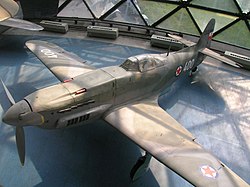Icarus S-49
| Icarus S-49 | |
|---|---|

|
|
| Type: | Fighter plane |
| Design country: | |
| Manufacturer: | |
| First flight: |
June 1949 |
| Number of pieces: |
112 to 227 |
The Ikarus S-49 was a single-seat Yugoslav fighter aircraft from the 1950s.
development
With the termination of relations between communist Yugoslavia and the Soviet Union in 1948, the Yugoslav air force found itself in an unfavorable position; at that time, Yugoslavia could not obtain warplanes from the west. Skepticism towards the new communist Yugoslavia was still too great in the West. At that time, the Soviet Yakovlev Yak-1 and Yakovlev Yak-3 formed the core of the Yugoslav Air Force. Their predominantly wooden structure, covered with plywood and linen, made it easy to maintain these aircraft. Because of the urgent need for new aircraft, but also out of fear of a possible intervention by the Soviet Union, the decision was made to start production of a domestic fighter aircraft. Kosta Sivčev, Slobodan Zrnić and Svetozar Popović were entrusted with the task. Before the Second World War, Ljubomir Ilić, Kosta Sivčev and Slobodan Zrnić had worked on the design of the Yugoslav fighter aircraft Rogožarski IK-3 and had relevant experience.
In June 1949 the prototype of the Ikarus S-49A, the first Yugoslav post-war fighter of domestic production, flew. Series production began at the Ikarus factories near Zemun and Belgrade . A 12-cylinder V-engine Klimow WK-105PF-2 of Soviet design with 1300 hp served as drive . The armament corresponded to that used in the Jakowlew fighters, while other components were taken over by both the Jak-3 and the IK-3, so that the Ikarus S-49 is considered a mixture of the Jakowlew Jak-3 and Rogožarski IK-3 .
In 1952 the further developed Ikarus S-49C appeared . Since it was no longer possible to procure the Soviet Klimov engines, the Hispano-Suiza HS 12Z-17 was chosen as the new drive . This required a redesign of the S-49 fighters, as the Hispano-Suiza engines were larger and heavier than the Klimow engines. There were two versions of the S-49C, the second of which finally went into series production.
commitment
Depending on the source, between 112 and 227 Ikarus S-49s were produced. Some of the aircraft were never used operationally, but served to supply spare parts. The Ikarus S-49 served in the Yugoslav Air Force until the early 1960s, after which it was replaced by the North American F-86 .
Technical specifications
| Parameter | Data Ikarus S-49A | Data Ikarus S-49C |
|---|---|---|
| crew | 1 | |
| length | 8.43 m | 9.06 m |
| span | 10.30 m | |
| height | 2.90 m | |
| Max. Takeoff mass | 2950 kg | 3568 kg |
| drive | a Klimow WK-105 PF-2 ; 1,300 PS (approx. 960 kW) | a Hispano-Suiza HS 12Z-17 ; 1,500 PS (approx. 1,100 kW) |
| Top speed | 554 km / h | 628 km / h |
| Climbing time to 4000 m | 3.9 min | |
| Climbing time to 6000 m | 6.27 min | |
| Service ceiling | 10,000 m | |
| Range | 690 km | |
| Armament | one 20 mm MK SchWAK two 12.7 mm MG UBS |
one 20 mm MK MG 151 two 12.7 mm MG Browning M2 2 × bombs each 50 kg or 4 × 127 mm HVAR (high velocity aircraft rockets) |
